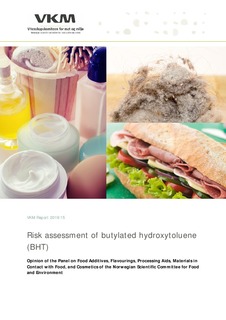| dc.description.abstract | Butylated hydroxytoluene (BHT, E321) is a synthetic antioxidant authorised as food and feed additive in the EU. In addition, BHT is used in e.g. cosmetics and food contact materials. To our knowledge, risk assessments including exposure estimates for BHT from multiple sources and exposure pathways have not been performed. BHT is characterised by extensive use and multiple exposure sources and routes. Therefore, it is important that these sources and routes are included in the estimations to arrive at the most accurate picture of the population's exposure. In addition, the main sources contributing to the exposure should be identified. Toxicity An acceptable daily intake (ADI) of 0.25 mg/kg bodyweight (bw) per day was established by EFSA based on effects on the litter size and pup body weight in two 2-generation studies in rats (EFSA, 2012). The ADI was based on the no observed adverse effect level (NOAEL) of 25 mg/kg bw per day in these two studies and an uncertainty factor of 100. The ADI was used as reference point for BHT toxicity in this risk assessment. Exposure The exposure was estimated for «realistic» and «high» scenarios. The consumption data used for the exposure estimation were from Norkost 3 (foods), EuroMix (foods and personal care products) and the Environmental Protection Agency (US; indoor dust). The concentration data used were from scientific literature, and identified through literature searches. The concentration data for the exposure estimation from foods and PCPs were limited and therefore considered to be the largest source of uncertainty in the exposure estimates. Data considered most realistic for the Norwegian exposure were used for «realistic» exposure estimation, whereas the «high» exposure scenario was a worst-case estimation representing a risk assessment for potentially high consumers. To calculate the total internal exposure, absorption factors for BHT uptake from the gastrointestinal tract and skin were used. BHT reaching the physical barriers in the body was defined as external exposure, and the absorbed BHT was defined as total internal exposure. The «realistic» total internal exposure from all routes, for the lowest 5 and the highest 95 percentile, was estimated to be within 1.4 – 9.7 µg BHT/kg bw per day for females and 0.8 – 9.7 µg BHT/kg bw per day for males. The 50 percentile was estimated to be within 3.5 – 4.2 and 2.2 – 2.8 µg BHT/kg bw per day (rounded numbers) for females and males, respectively. The «high» total internal exposure from all routes, for the lowest 5 and the highest 95 percentile, was estimated to be within 23 – 281 µg BHT/kg bw per day for females and 9 - 319 µg BHT/kg bw per day for males. The 50 percentile was estimated to be within 85 – 111 and 46 – 61 µg BHT/kg bw per day (rounded numbers) for females and males, respectively. The predominant route of exposure is oral intake; on average 80% of the internal exposure in females is from food, dust and oral intake of PCPs, while for males even more (92%). Sources of BHT exposure were mainly from food through oral intake (females 41%, males 59%, with substantial contributions also from PCPs through oral uptake (females 38%, males 34%) and through dermal uptake from PCPs (females 21%, males 7.1%). The main contributors to the estimated dietary «realistic» external exposure were the food groups «milk, cream, ice cream», followed by «chewing gum» and «fatty fish». The personal care product categories «body lotion» and «deodorant»» were the two major contributors to the estimated dermal «realistic» external exposure. Oral exposure from personal care products was mainly from toothpaste. Risk characterisation and conclusions Both «realistic» and «high» total internal BHT exposure was used in the risk characterisation. The estimated «realistic» exposure was below the ADI for both women and men. The 50 percentile of the estimated «high» exposure (the worst-case estimation representing a cautious risk assessment approach) was below the ADI, whereas the 95 percentile was above the ADI. Thus, a small fraction of the population may exceed the ADI and be at risk for negative effects on reproductive health. The Panel concludes that BHT exposure is unlikely to cause adverse health effects in adults. | nb_NO |
